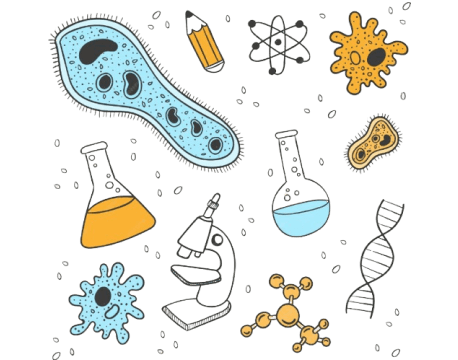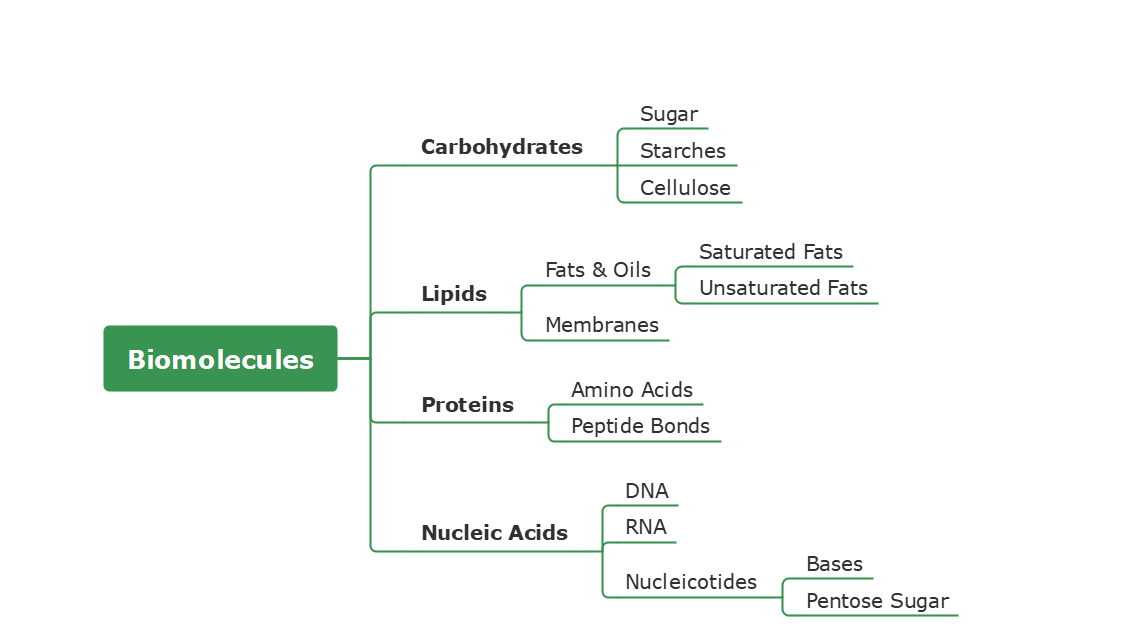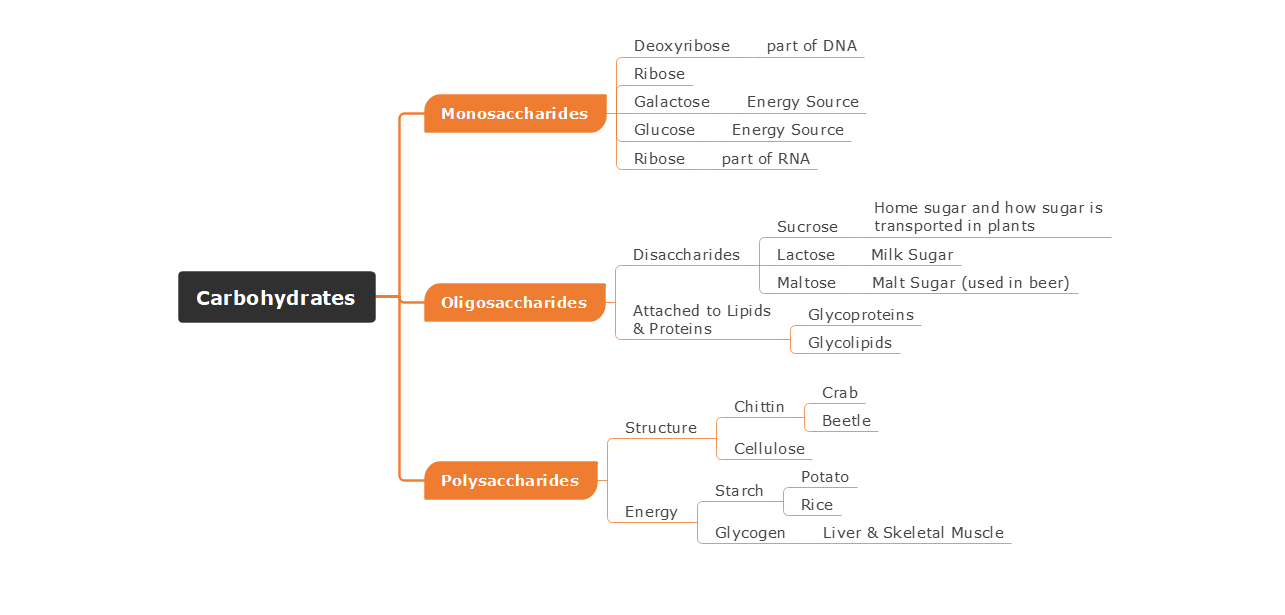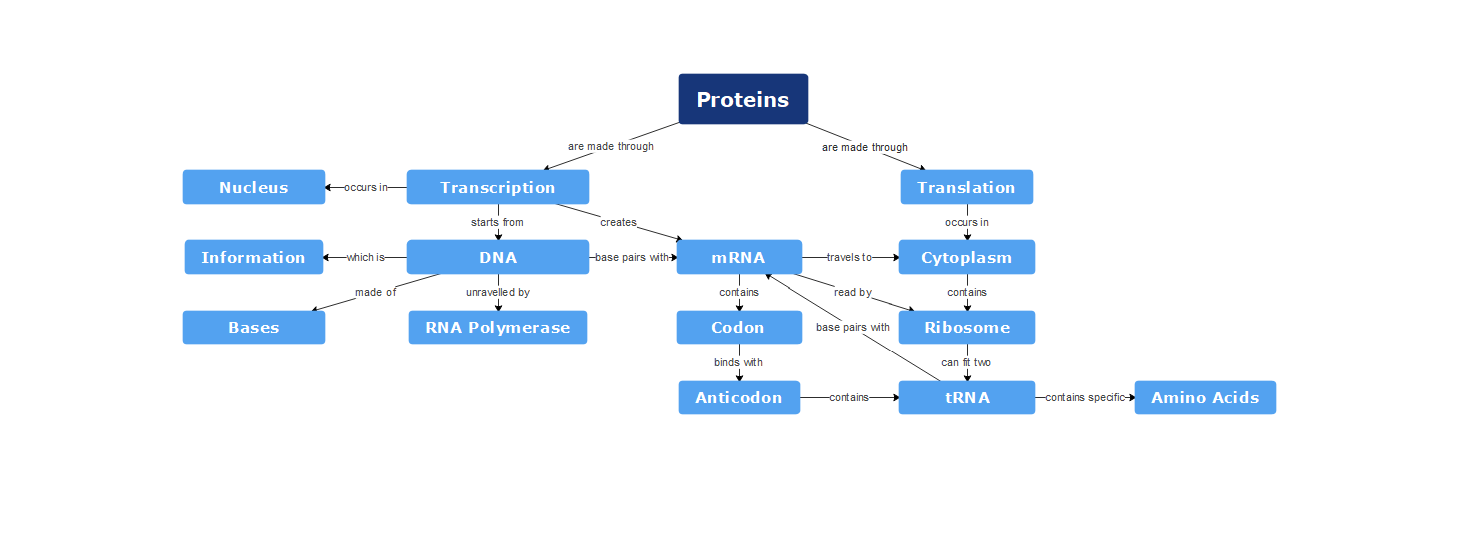The cell is the fundamental building block of life, consisting of various sub-cellular particles. Therefore, to survive, all cellular organisms require energy obtained from nutrients. Biomolecules can be classified into macromolecules and micromolecules, both found in nutrients.
As a student, it can be challenging to grasp the concepts of protein synthesis and carbohydrates' various types and subtypes. Similarly, as a teacher, you may find that your students need help to entirely comprehend the concepts related to biological macromolecules. This article will explore the benefits of using concept maps to enhance your understanding of macromolecules and their various types and subtypes.
In this article
What are Macromolecules
You must have heard about fats, carbs, and proteins in your food, but did you know these molecules are also inside your body? Macromolecules are defined as sizable molecules present within cellular structures and play a crucial role in facilitating various processes necessary for the survival of organisms. Macromolecules, namely carbohydrates, nucleic acids, lipids, and proteins, are frequently present in all living organisms.
The macromolecule is made up of 10,000 plus atoms. They comprise chains of smaller molecules tied together through covalent bonds. The smaller molecules of macromolecules are known as monomers.
Macromolecules, or the number of monomers, are known as polymers. However, carbon (C) is the main element in monomers and polymers; they can also contain hydrogen (H), nitrogen (N), oxygen (O), and maybe even small amounts of other elements.
Different Types of Macromolecules
Four main types of cellular macromolecules play the primary role in the cellular processing of living organism systems:
1. Carbohydrates
Carbohydrates consist of carbon, hydrogen, and oxygen and are characterized by their polymer structure. These compounds can be categorized into monosaccharides, disaccharides, and polysaccharides. Carbohydrates are present in several sources, such as starch, fruits, vegetables, milk, and sweets. They constitute a significant component of a nutritious dietary plan.
2. Nucleic Acids
The nucleic acids encompass deoxyribonucleic acid (DNA) and ribonucleic acid (RNA), macromolecules composed of nucleotide monomers. Nucleotides consist of a pentose group, a phosphate group, and a nitrogenous base group. All genetic information is contained within the deoxyribonucleic acid (DNA). DNA is transcribed into RNA, which is then translated into proteins.
3. Proteins
The long chains of amino acids make up proteins. The acidic group and the amino group are two examples. Without proteins, there would be no lipids or carbohydrates because the processes that make them are proteins.
4. Lipids
Lipids are a class of macromolecules characterized by their hydrophobic nature, meaning they lack solubility in water. These involve triglycerides, carotenoids, phospholipids, and steroids. Lipids are crucial in various biological processes, including constructing the cell membrane, synthesizing hormones, and serving as a source of stored energy.
☀️Related topics
How Macromolecules Participate in Biological Processes
1. Genetic Information
Nucleic acid macromolecules are the polymers that transmit, store, and convey genetic information. Nucleic acid sequences contain heredity information in the form of monomers. There are two types of nucleic acid.
- Deoxyribonucleic Acid (DNA)
Genetic information or inheritance from parents to children is carried by and passed on by DNA.
- Ribonucleic Acid ( RNA)
RNA acts as a middleman to specify the amino acid sequences of proteins by the information stored in DNA.
2. Structural Support
Cells and tissues depend on macromolecules to keep their structures together. In the form of fibrous proteins like collagen, proteins provide structural support. Lipids, especially phospholipids, provide the structural base for cell walls.
3. Enzymatic Reaction
Proteins speed up and help biochemical processes happen by acting as enzymes. Enzymes are essential in metabolic routes, DNA replication, protein synthesis, and other critical cellular functions.
4. Transportation
Proteins are essential for moving molecules inside and outside of cells. Some examples are membrane proteins that help things move across cell membranes and hemoglobin that carries oxygen through the blood.
5. Energy Transfer
Energy storage and release are both done by macromolecules like carbs and lipids. Energy comes from carbs like glucose, broken down in glycolysis and cellular respiration processes.
Macromolecules Concept Map Examples
As we have discussed, there are four main types of macromolecules. Learning further classification of each macromolecule can be a tough nut to crack. Here comes a Concept Map to the rescue; it can help you visualize a complex relationship into more straightforward concepts by breaking it down.
For better learning, let’s discuss some macromolecules concept map examples from the Edrawmind template gallery. You can also further customize these concept maps according to your needs.
1. Macromolecules Concept Map
This macromolecules concept map can be a big help in actively learning macromolecules. The example visually represents all four types of macromolecules, which include carbohydrates, lipids, proteins, and nucleic acid. Moreover, each of them is further divided into sub-types. This way, the learner can easily understand and learn each type.
Learners can customize it for themselves. Moreover, they can add further subtypes and even functions of each type. If you are more of a tangible learner, you can print it out and attach it to your biomolecule chapter.
2. Carbohydrates Concept Map
If you want to learn in-depth about carbohydrates, then a concept map is your go-to. This carbohydrate concept map starts from the basics, which are three main types: Monosaccharide, Oligosaccharide, and Polysaccharide. Further, the concept map is broken down into sub-types of each primary type and extended to explain their use and functions.
The carbohydrate concept map can be your best friend in learning from basics to the most complex relationships between each type of carbs.
3. Protein Concept Map
With this protein concept map, you can learn everything you need to know about proteins and how they are made. There are two ways that proteins are synthesized: transcription and translation. As you can see from the concept map, transcription takes place in the nucleus, and translation takes place in the cytoplasm.
You can use this protein synthesis concept map to understand better how different steps work together and to get a better grasp of the whole concept.
Conclusion
And that brings us to the end of our exploration into the world of tiny molecules called macromolecules. These small molecules, like carbohydrates and proteins, are the key players working behind the cells' complex functions.
If you want to make learning about these small things more enjoyable, you can use EdrawMind. It's a helpful tool that makes generating visuals and understanding macromolecules easy. But you know what? EdrawMind is not only for macromolecules but also a versatile tool that can be used for various purposes.
You can use it to collaborate with friends, brainstorm ideas, and see everything happening in real-time. EdrawMind has pre-designed macromolecules concept map templates and a collection of attractive mind maps, which makes learning very simple.
Whether you're studying biology or simply looking to enhance your ideas, try using tools like EdrawMind. It makes it easy and fun to understand both small things and big ideas.





 below.
below.  below.
below. 

